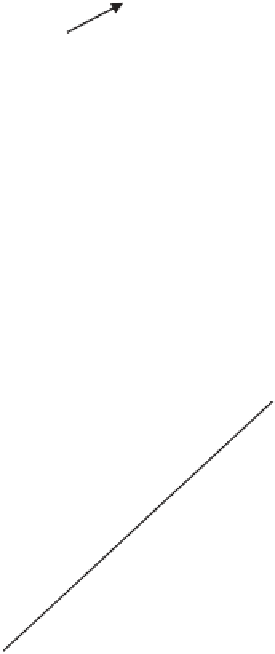Geography Reference
In-Depth Information
Table 11.13. Measured catchment area and calibrated root zone storage, S
max
, and catchment contributing factor, a
Reservoir
1
2
3
4
5
6
7
8
Catchment area (ha)
S
max
mean (mm)
822
45
518
42.5
144
45
403
42.5
357
32.5
1549
25
1829
45
194
37.5
S
max
low/high (mm)
35/55
35/50
40/50
40/45
20/45
15/35
35/55
20/55
a (day/mm)
0.010
0.025
0.063
0.060
0.080
0.013
0.020
0.035
The location of the reservoirs is given in Figure 11.61.
Figure 11.63. Example showing
on the left axis, observed reservoir
storage (triangles) and accumulated
quickflow (mm) (bold line) and, on
the right axis, the rainfall (mm/day),
on the basis of which S
max
and a
have been estimated. The series
covers the 2005 season for reservoir
6in
Figure 11.61
.
25
0
10
20
20
Cumulative
Qf
Precipitation
30
15
40
S
max
in period
of first runoff
production
Reservoir is full:
spilling
50
10
60
70
5
80
90
Fitting with '
a
'
0
100
Figure 11.64. Observed and
predicted cumulative runoff for all
eight catchments, with (left) the
calibration year 2005 and (right)
the validation year 2006.
2005
2006
75
75
60
60
45
45
Reservoirs
1
2
30
30
3
4
15
15
5
6
7
8
0
0
0
15
30
45
60
75
0
15 30
observed cumulative
45
60
75
observed cumulative
D
V
ws
(mm)
D
V
ws
(mm)
the reservoir areas became constant and could no longer be
used as a runoff gauge. The data obtained from the satellite
images and the volumes predicted by the model were well
correlated with an overall coefficient of determination (r
2
)
of 0.83 in 2005, and of 0.92 in 2006.
2006. The filling process of small reservoirs comprises
rainfall directly on their surface areas and a quickflow
contribution from their catchments, made up of interflow
and surface runoff.
Our results show that, in ungauged basins, time series of
small reservoir surface areas can be used to parameterise
and validate simple hydrological models. This is important
since the array of new data products with good spatial and
temporal resolution obtained from remote sensing can be
used as input landscape parameters for hydrological
models but do not provide detail on the temporal
Discussion
Despite the different rain patterns in 2005 and 2006, the
Thornthwaite
Mather parameters AWC and a that were
determined in the year 2005 are able to model the runoff in
-

































































































































Search WWH ::

Custom Search